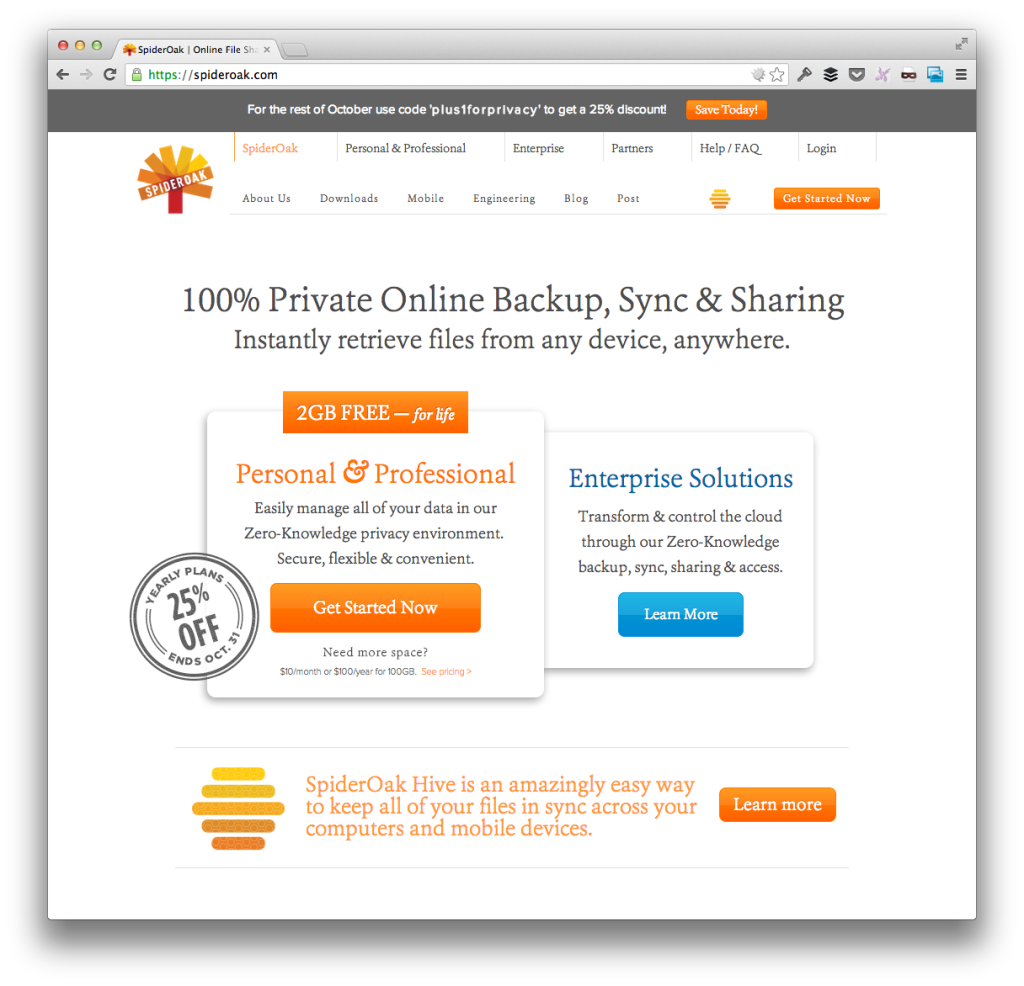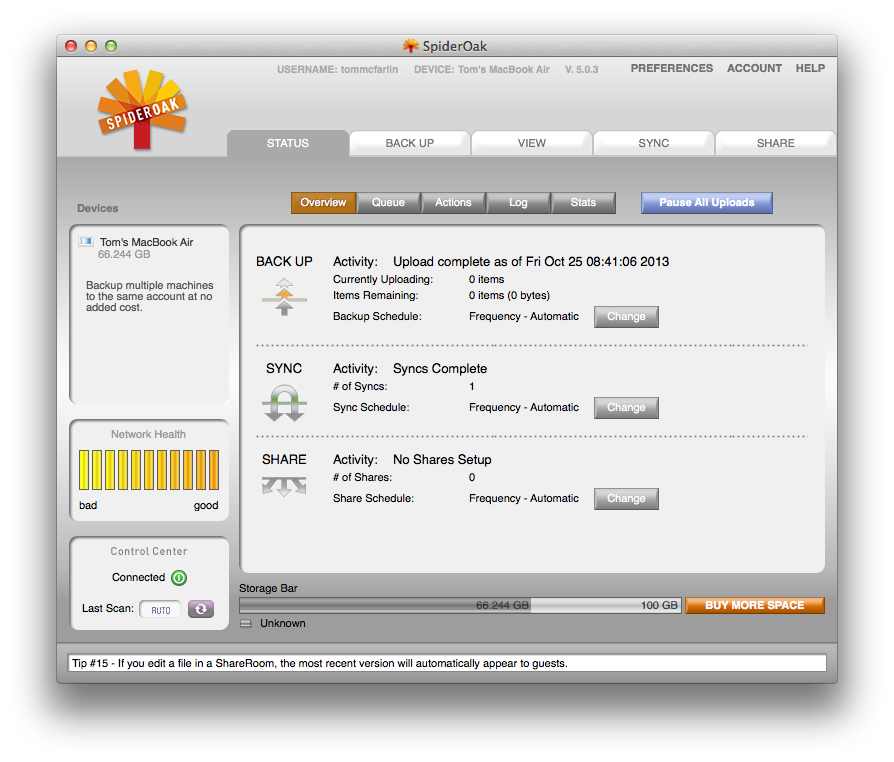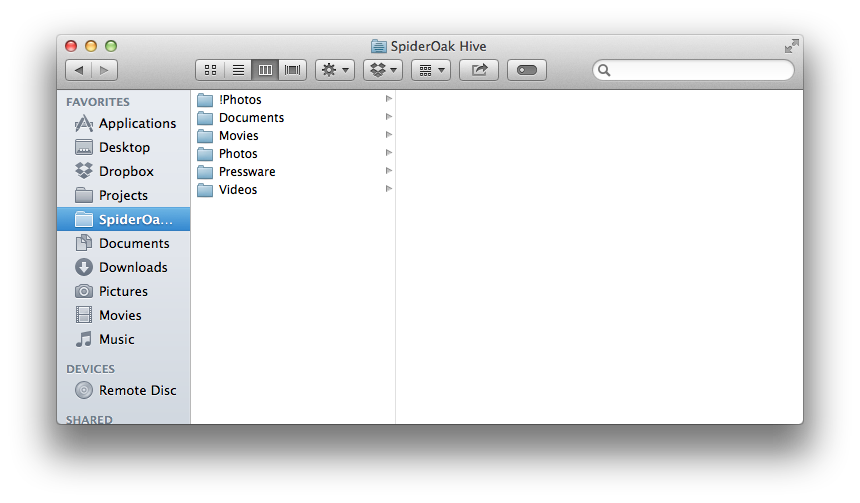A couple of months ago, I came across an interesting article by Doug Belshaw that covered his thoughts and experiences with Dropbox, SpiderOak Hive, and why he made the jump from one to the other. In short (and straight from his blog):
I’m moving from Dropbox to SpiderOak for file sync/backup. SpiderOak not only encrypts files in transit, but on their servers. The encryption key stays on the user’s machine so SpiderOak employees (or anyone else) can’t get access to your files.
Shortly after reading the article, giving it some thought of my own, and taking an in-depth look at SpiderOak, I ended sharing the following:
so i made the switch and am giving spideroak hive a try. keeping dropbox free, but everything else is going into spideroak.
— Tom McFarlin (@tommcfarlin) August 29, 2013
My current setup – as mentioned – is the free Dropbox plan (with which I have 6.2GB of space), and a SpiderOak Hive subscription for 100GB. It’s been just shy of two months, so I thought it was time to follow-up with my experience thus far.
Wait, What is SpiderOak Hive?

SpiderOak – in the same vein as Dropbox – is a way for you to store files and sync them across multiple devices (including iOS and Android).
But here’s the thing: Whereas information kept on Dropbox’s infrastructure is kept unencrypted such that anyone – including Dropbox employees – could potentially read the information, SpiderOak’s encryption works so that only you can access the data.
Straight from the SpiderOak site:
Our ‘zero-knowledge’ privacy environment ensures we can never see your data. Not our staff. Not a government. No one. The myth about ‘online’ and ‘privacy’ has been dispelled – leaving an environment whereby it is impossible for us to betray the trust of our users.
Simply put, your password is the key to decrypting the data. If you forget your password, then you’ve essentially lost the key to the kingdom – you can’t do a password reset.
What’s The Application Like?
Inevitably, SpiderOak is going to be compared to Dropbox, so I’ll be making some of those some comparisons here; however, I’ll also do what I can to have a neutral stance on features that are unique to SpiderOak.
So the first thing is the application itself. Like Dropbox, it leaves a a small icon on your Finder toolbar (or in your system tray if you’re on Windows). It animates when it’s backing up, and stays stagnant the rest of the time.
The core application has a much more involved interface than Dropbox. Where Dropbox’s configuration interface is basically a small window with a few tabs and options, SpiderOak’s application looks like this:

The SpiderOak Application. Yikes!
Immediately, you notice that the interface looks specialized. I can only assume that this is because the application is cross-platform and so whatever language the front-end was written – perhaps Java? – it looks the same across all platforms.
Because it’s clearly more complicated, it takes a little while to adjust, but once you understand what you’re looking at, it’s really not that hard to follow nor do you have to jump into the configuration that often once you’ve set it up.
Despite the complexity of the user interface, I do like the fact that it gives such detailed information especially during the course of a backup. You know how many files are left to encrypt and sync, the status of each, and you know how many have been uploaded.
What About The Sync’d Directory?
Just like Dropbox, the SpiderOak Hive directory looks and functions just like Dropbox:

The SpiderOak Hive Folder
As you can see, SpiderOak adds itself to the Finder window (I’ve placed it just below Dropbox, obviously) and you can see a couple of the directories that I have backing up to SpiderOak.
Just as with Dropbox, as soon as you drop files into the directory, they’ll immediately begin the syncing process.
How Long Does It Take To Sync?
Honestly, it takes longer to sync than it does with Dropbox, but for a simple reason: There’s a process of encryption that happens during the course of the syncing that Dropbox (and other similar software) does not do.
This results in longer upload and download times, but it comes at the sake of security.
What About The Mobile App?
I have the SpiderOak mobile app and its decent, but I think this is where there’s most room for improvement is it relates to some of its competitors.
For example:
- I’d love to be able to have a “camera upload” feature that will allow for syncing photos from my phone to SpiderOak ala Dropbox.
- Right now, there’s no Apple TV integration so if you have videos in your SpiderOak Hive that you want to display on your television, you’re out of luck.
- If you wish to quickly view something on your phone, similar to how you can with Dropbox, a download process has to occur (which make sense because of the encryption), but it takes a little while to pull it up.
Truth be told, I don’t use the mobile app that much. Then again, I don’t use Dropbox’s mobile app that much, either. For the most part, I use it as a way to quickly back up photos that I’ve taken, and I use it to stream some videos via Apple TV.
Other than that, that’s it.
Can Your Share Files?
Yes you can. SpiderOak offers what’s called a ShareRoom with which you can grant access to however many other people you’d like to retrieve files. This is analogous to Dropbox’s shared folders.
I’ve actually never had to use this feature before, so I’ve little to say about it; however, it’s nice to know it’s there should I need to shoot a file over to a family member (which I occasionally need to do).
Are You Sticking with SpiderOak?
Yes, I am, but only because the free Dropbox plan is part of my workflow and SpiderOak is used for most everything else.
The way that I organize my files are as follows:
- Photos and Videos taken with the phone are synced to Dropbox using the Camera Upload feature
- Personal documents are kept in SpiderOak Hive
- Projects are kept in Dropbox because of the rapid sync feature. I also use version control so I have doubly-backed up copies.
- Non-critical documents or things that I may need while quickly on the go are kept in Dropbox
In short, Dropbox is a “working directory” of sorts for me. It’s a temporary place where I keep things that I’m working on right now (or for the month) that will eventually move on to a different location for back up.
Ultimately, I’ve been impressed with SpiderOak. The price is great, the speed is fair, the mobile app could be improved, but isn’t terrible, and I rest easier knowing that the information is encrypted (because, yes, I’m one of those people).
Sure, they have room for improvement, but it’s only going to refine a quality service, in my opinion.


Leave a Reply
You must be logged in to post a comment.